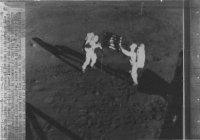| Wirephoto transmitter TS 975 (1960) | ||||
|
As the name implies, wire-photo devices can transmit documents having grey tone or color value pixels, i.e. black-and-white pictures or color pictures. The portable wire-photo transmitter TS 975 could be used by reporters to transmit actual black-and-white pictures, e.g. pictures of a sports event, quickly to their editorial office. These devices were first used at the Olympic Games at Rome in 1960. |
||||
|
Scanning of the picture (max. 13 x 18 cm), which is mounted on a scanning drum, is done
photo-electrically with a scanning lamp and a photo multiplier, which converts the reflected
light into an electrical signal. The scanning lamp and the photo multiplier are integrated in a
scanning head, which moves along the rotating drum. The picture received in the editorial
office is recorded by a wirephoto transceiver on photographic paper. Transmitting was done
over special image lines, which were operated by public picture transmission offices or by
press agencies.
Wirephoto devices were not only used in press environments for the transmission of actual
pictures, but also in many cases by police departments for transmitting police portraits and
fingerprints. After the first weather satellites became available, wire-photo receivers were also used for
recording satellite pictures. |
||||
|
Portable Transmitter TS 975 (1959)
(English, 392 Kbyte)
|
||||
|
Telebildsender TS 975 (Klischograph 3-1960)
(German, 299 Kbyte)
|
||||
|
Telebild Sender TS 975 (1965)
(German, 634Kbyte
|
||||
|
These three images of the landing on the moon (Apollo 11) were
sent from the USA to the test workshop at Hell in Kiel, for test
purposes in 1969. An employee remembered these originals
these days and handed them over to the Hell-Verein
for storage and presentation at a future exhibitions.
|
||




